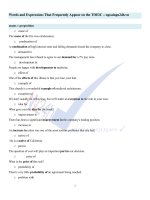Connecting words adding information
Bạn đang xem bản rút gọn của tài liệu. Xem và tải ngay bản đầy đủ của tài liệu tại đây (8.63 KB, 1 trang )
Connecting words: adding information
ESL students often fail to connect their sentences and ideas with appropriate connecting words. Although this
doesn’t necessarily make their prose grammatically incorrect, it affects the flow of ideas.
Good writers use a large number of words and phrases to show relationships between ideas and information. In
grammars these linking words are called
transitional adverbs
or
conjunctive adverbs.
Here is an overview of the most common transition words in English.
To add information
In order to add more information to what has already been said, you can use the following conjunctions and
transitional adverbs:
Conjunctions: and, as well as, not only…but also
We have got a car
and
a bike.
We have got a car
as well as
a bike.
We have got
not only
a bike
but also
a car.
Transitional adverbs: moreover, in addition, furthermore, again, what’s more, besides, equally important, too, also
Examples are given below
Smoking makes you smell bad.
Moreover
, there is now clear evidence that it causes cancer.
Mr. Rai has earned the respect of laborers everywhere.
Furthermore
, they know they can trust him.
Smoking is dangerous.
What’s more
, it makes you smell bad.
Regular physical exercise helps you burn those unwanted calories.
In addition
, it relieves stress.
Besides
being a colleague, he is my best friend.
Notes
Also, as well
and
too
have very similar meanings. But they do not go in the same position in clauses.
He not only smokes; he
also
drinks.
He not only smokes; he drinks
as well
.
He not only smokes; he drinks,
too
.
Be first to know when grammar rules change! Sign up to our newsletter here: englishgrammar.org (It's free)
Powered by TCPDF (www.tcpdf.org)









